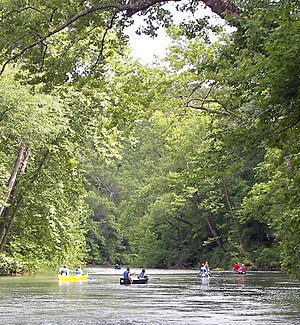 Image via Wikipedia
Image via WikipediaUnder new leadership, the Missouri Department
of Conservation tackled challenges old and new.
JEFFERSON CITY–Looking back on 2010, historians are likely to describe a year when economic challenges spurred conservation innovations and a new leadership team launched ambitious initiatives. It was also a year when the Show-Me State’s world-class fishing repeatedly made national news.
As 2010 began, revenue from Missouri’s one-eighth of 1-percent conservation sales tax was in its fourth consecutive year of decline. Sales-tax income fell from $103.3 million in Fiscal Year ’07 to $93.9 million in FY ’10, and projected sales-tax income for the current fiscal year was projected to be $92.7 million. To adapt to falling revenues, MDC moved to cut its workforce by 10 percent, close 13 offices and adjust some programs.
While implementing these budget cuts, the agency got new leadership. Bob Ziehmer replaced retiring Director John Hoskins on Jan. 15. By July 1, six of the agency’s 10 division chiefs had retired as part of MDC’s payroll reduction effort and were replaced from within the agency’s ranks. Over the course of the year, MDC’s new leadership team launched several initiatives to achieve further cost savings or advance MCD’s mission.
They unveiled the year’s first initiative in February, announcing plans to test a new system for assigning waterfowl hunting opportunities on three of its managed wetland areas. “Quick Draw,” as the new system is known, went into effect at Eagle Bluffs, Grand Pass and Otter Slough conservation areas (CAs) in the fall as a test to determine whether the online system could enhance convenience and hunter participation while saving money. Thousands of hunters tried the new system, and managers of the three areas said they noticed an increase in the number of new faces arriving for waterfowl hunts. Hunters who took part in “poor line” drawings for unreserved hunting spots found more opportunities than expected under the new system. MDC will evaluate the system’s effectiveness after the hunting season before deciding whether it should be expanded to other areas.
In March, MDC announced plans to distribute nearly $6 million in grants to help seven schools reduce energy costs, create jobs and provide incentives for better forest management. The Fuels for Schools grant program was a cooperative effort with the USDA Forest Service and was funded through the American Recovery and Reinvestment Act. It helped participating schoolsinstall boiler systems that use woody biomass to heat and cool their facilities. Besides cutting schools’ fuel bills, the program helps reduce dependence on fossil fuels, supports local employment and supports the state’s forest industry. It also benefits conservation by giving landowners a financial incentive to conduct timber-stand improvements harvests and other management practices that enhance forest productivity and wildlife habitat.
Perhaps the most heralded initiative launched in 2010 was a plan to restore elk to a 346-square-mile area in parts of Shannon, Carter and Reynolds counties. The Conservation Commission approved the plan in October, and MDC forged ahead immediately. Elk will be released into the wild at Peck Ranch Conservation Area (CA) in late April or early May.
Expected benefits of elk restoration include restoring a key ecological link to the Ozarks, boosting Missouri’s tourism industry and providing hunting opportunities once the herd can sustain a harvest. The full elk-restoration plan is available at www.mdc.mo.gov/elk/.
Following is a month-by-month roundup of some of the year’s other significant conservation-related events.
JANUARY
Anglers made some of the Show-Me State’s biggest news last year. The action began Jan. 19, when 15-year-old Joshua Lee Vance of Bolivar gigged the 4-pound, 5-ounce white sucker from the Niangua River. It was the first white sucker entered in the “alternate methods” category.
Around the same time, archery deer hunters were wrapping up their four-month-long season. The 2009-2010 archery deer harvest topped 50,000 for the first time in the modern bowhunting season’s 64-year history.
Thanks to deer hunters’ success, the Conservation Federation of Missouri reported brisk activity in the Share the Harvest program, which encourages hunters to donate venison to food pantries. Donations topped 252,000 pounds of venison during the 2009-2010 hunting season and brought the total for the program’s 18-year history to more than 2 million pounds.
FEBRUARY
The first issue of Xplor: kids’ adventures in nature arrived in mailboxes around the state. The bi-monthly magazine does for readers 7 to 12 years old what Missouri Conservationist magazine does for adults.
Testing confirmed chronic wasting disease (CWD) in a captive whitetail deer at a private hunting ranch in Linn County. Testing of deer from the ranch and of free-ranging deer from surrounding parts of Linn, Macon and Chariton counties found no sign of the disease, which affects deer, elk and moose. MDC continues CWD monitoring efforts that began in 2001.
More than 600 youths took part in Missouri’s second National Archery in the Schools state tournament. The program’s ranks have swelled to approximately 16,000 youths in just four years. This remarkable growth rate is evidence of archery’s enduring appeal.
MARCH
As winter faded into spring, state and federal officials issued fire warnings for a number of counties in southern and central Missouri, indicating an extreme danger of wildfire. The immediate causes of the danger were high winds, low humidity and a prolonged dry spell. However, the underlying causes go back three years, during which ice storms and high winds dumped countless tons of woody debris on the ground. Missouri got through the spring fire season without a major fire disaster. However, fire officials warn that the abundance of woody fuel will continue to pose a threat for a decade.
APRIL
On April 9, Nicholas Wray, of Harrisonville, caught a 2-pound, 4-ounce black bullhead from a Cass County farm pond using a jug line. The bullhead nudged aside the previous record by 4 ounces.
Hunters kicked off Missouri’s second half-century of turkey hunting in April. Unregulated hunting had almost eliminated the wild turkey from the Show-Me State by the 1930s. It took three decades of careful stewardship to rebuild the flock to the point where it could support a three-day hunting season in 14 Ozarks counties in 1960. Hunters checked 94 turkeys in the spring season that year. In 2010, the figure was 46,199, confirming Missouri’s status as one of the nation’s top turkey-hunting destinations.
MAY
Oak trees across a broad swath of Missouri experienced an unusual outbreak of a common parasite, the jumping oak gall wasp. The insects lay eggs in leaves, producing tiny, button-like growths that turn leaves brown. When the galls fall to the ground, larvae inside start moving around, causing the galls to jiggle, slowly working their way into protected spots. Tree experts reassured tree owners that the parasite is not fatal to healthy trees, even though the condition can look awful.
JUNE
One of Missouri’s most familiar invasive species, the zebra mussel, turned up on a private boat lift during an inspection of the Camp Branch Marina in Smithville Lake. MDC and U.S. Army Corps of Engineers worked together to eradicate the infestation later in the summer by applying almost 400 gallons of a commercial algaecide to the water around the marina.
The Lake City Shooting Range and Education Center in Jackson County, improving recreational shooting opportunities for Kansas City area residents.
JULY
Missouri’s world-class fishing made national news on July 8 when John West, of Republic, caught a 58-pound, 10.4-ounce striped bass at Bull Shoals Lake in Taney County. At that time, the International Game Fish Association (IGFA) line-class record for inland waters was 47 pounds, 11 ounces.
In the early hours of July 20, Greg Bernal, of Florissant, caught a 130-pound blue catfish on a handheld fishing pole while fishing on the Missouri River north of St. Louis. The monster topped Missouri’s previous pole-and-line record for blue catfish by 27 pounds.
July’s third record was a 99-pound flathead catfish caught by Robert Neal Davidson, of Mokane.
On July 17, MDC culminated a two-year undercover investigation in Crawford, Dent, Howell, Iron, Miller, Oregon and Shannon counties. Most of the 425 serious violations documented by state and federal wildlife officers were related to deer and turkey.
The Conservation Department, in cooperation with the St. Louis Zoo, released the first captive-reared eastern hellbenders into the Big Piney River this month. The release was part of efforts to help the endangered salamanders recover.
Efforts to restore alligator gar populations in southeast Missouri made national television in a National Geographic documentary that aired late in July.
AUGUST
At its Aug. 20 meeting in Jefferson City, the Conservation Commission announced that it would appeal a judgment by Ripley County Circuit Judge Robert Smith concerning regulations that prohibit the use of motorized vehicles and dogs for deer hunting. Smith had ruled earlier in the month that the regulations were unconstitutionally vague.
Missouri’s Golden Anniversary Wetland Initiative forged ahead with renovation work at Duck Creek CA. The initiative is replacing aging infrastructure at Missouri’s oldest managed wetland areas.
SEPTEMBER
In September, MDC announced the closure of Missouri’s ruffed grouse hunting season for the first time in more than 25 years. Grouse numbers remained low despite repeated attempts to reintroduce grouse in areas with suitable habitat. MDC and the Ruffed Grouse Society were seeking a source of grouse to resume reintroduction work, so hunting grouse made no sense while restoration work was under way.
OCTOBER
George Pittman Sr. put Missouri fishing back in the news on Oct. 12 by landing an 8-pound, 3-ounce shortnose gar with a rod and reel at LakeContrary in his home town of St. Joseph. It topped the previous Missouri state record by 3.5 pounds and was more than a pound heavier than the current IGFA record.
Black bears also made the news as MDC launched a multi-year field study of Missouri’s growing bear population. The study will provide information about movement patterns, population densities, habitat preferences and overall numbers of Missouri bears. The data will establish a firm scientific basis for bear management, so that bears continue to thrive and expand into suitable habitats with minimal conflicts with people. Hunting is expected to be part of Missouri’s long-term bear management strategy.
A weekend of free shooting heralded the reopening of the Jay Henges Shooting Range at High Ridge, augmenting public opportunities for recreational shooters in the St. Louis area.
NOVEMBER
Just in time for deer season, the Missouri Court of Appeals stayed Ripley County Circuit Judge Robert Smith’s ruling on hunting deer with dogs and vehicles. The Court of Appeal’s order enabled conservation agents to continue enforcing the contested Wildlife Code provisions until MDC’s appeal is resolved.
When deer hunters went afield during the November portion of Missouri’s firearms deer season, their ranks included a few practical historians wielding atlatls, spear-throwing devices used by humans as long as 30,000 years ago. No atlatl kills were reported.
Gov. Jay Nixon shot an 8-point whitetail buck on opening morning of the November deer hunt and donated the venison to needy Missourians through Share the Harvest. Earlier in the fall, Gov. Nixon announced that Share the Harvest had the resources to underwrite processing of up to 10,000 deer, more than double the number in previous years. The expansion was possible because of a partnership between Gov. Nixon, MDC, the Conservation Federation, and local food banks. For each whole deer contributed, the Conservation Federation reimbursed local processors $60, up from $40 in 2009. In many cases, local charities covered the balance of the processing cost, making donations free for hunters. Through efforts like this, the Conservation Federation hopes to boost venison donations to half a million pounds annually.
DECEMBER
In December, MDC construction crews working with teams from Kentucky and Virginia began building elk traps and pens in Kentucky. The next step is construction of a holding pen at Peck Ranch CA. The Appalachian Wildlife Foundation and the Rocky Mountain Elk Foundation pledged financial support totaling $350,000 for Missouri’s elk-restoration efforts.
MDC announced that it had confirmed the 11th mountain lion sighting in Missouri since the big cats disappeared from the Show-Me State in the mid-1800s. A landowner in southern Platte County near the Missouri River contacted MDC with a photograph he took of a mountain lion in a tree on his property. The confirmation came after experts examined the photo and interviewed the landowner, who asked to remain anonymous. MDC experts also examined claw marks on the tree where the big cat was photographed and gathered hair samples for DNA testing in hopes of gaining information about the animal’s origins.
With 18 days of archery deer hunting and the late portion of youth deer season still ahead, Missouri’s 2010-2011 deer harvest stood at 269,759.
-Jim Low-



















